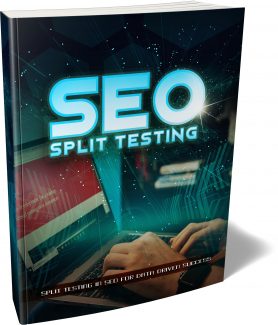 License Type: Master Resell Rights
License Type: Master Resell Rights  File Type: ZIP
File Type: ZIP
 SKU: 62945
SKU: 62945  Shipping: Online Download
Shipping: Online Download
Sample Content Preview
SEO (Search Engine Optimization) is never a completely sure thing. If a company claims that it can guarantee to get you to the top spot in the SERPs (Search Engine Results Pages) for any given keyword, you should run a mile: they’re blowing smoke.
While this is true however, what is also true is that some methods are more successful than others. And some are more of a ‘sure thing’ than others.
And in that regard, the SEO strategy that is perhaps the closest thing there is to a guaranteed route to success… is split testing.
Split testing essentially means taking a rigorous and somewhat scientific approach to your search engine optimization, which effectively means removing the guess work from the process. In fact, what split testing really amounts to, is helping your site to ‘evolve’ to become the most optimized version of itself.
How does all this work? It’s actually very simple, although not without a great deal of nuance that can determine the success of such endeavors. When done well, split testing can mold any website or blog into a hugely successful titan that catapults every new post to the top of Google. When done incorrectly, split testing can jeopardize all your hard work and risk getting your site removed entirely. It’s high-risk, high-reward; but it’s also perfectly accepted by Google and a skill that’s 100% worth developing.
In this eBook then, we’re going to take a deep dive looking at the power of split testing for SEO. You’ll discover how to use this strategy employing the most effective tools, how to avoid common mistakes, and how to use split testing in a host of other capacities too: such as to help sell a product, or improve engagement with your audience.
Once you master this skill, you’ll be able to take your SEO activities to another level.
Before we go any further, just what is split testing? And what does the term mean in the context of search engine optimization?
Essentially, split testing means taking a product, marketing material, or anything else and creating two slightly different versions of it in order to see which one performs best.
This is used by businesses all the time in the real world and helps them to make smarter decisions and to avoid wasted investments. Let’s imagine for a moment that you own a chain of fast food restaurants that sell only prawn-based dishes (because why not).
Your store has been doing fairly well, but then you hear somewhere that on average, takeaways with red and orange colorschemes on their premises tend to earn more. Why? Because those colors increase the heartrate and make people slightly uncomfortable. Therefore, they are more likely to eat quickly and to leave the area, freeing up the table for the next customer. The result is that such venues actually see a higher turnover of customers, and greater profits. This is just a random example, but it also happens to be true!
The problem is that Prawns4U happens to use a blue colorscheme in its interior design. What if you could increase your daily profits in all stores by coloring the store red?
Problem is, this could just as well backfire. What if you hurt brand recognition and thereby reduce your sales drastically? What if the lack of nautical color theme means that people feel less… fishy? Whatever the case, you now have three choices.
A) Leave your stores as they are and leave potential profits on the table
B) Change the color of your stores and hope that this doesn’t hurt your ranking
C) Run a split test And of course, the last option is the one that will stand to serve you best.
To perform this, you will now instruct just two or three of your 50 stores to change the color of their interiors. You’ll then monitor the progress of those stores for the next 6 months, and then collect all the data together to see what it can tell you.
What you’re looking for, is a sign that the stores that were colored red:
A) Saw a spike in profits and turnover
B) Outperformed the stores that did not change anything
If the change helped to boost your store’s success, then you might choose to adopt the change and thereby roll it out across all your stores – potentially seeing a large spike in traffic.
If the change hurt your store’s success, then you simply change it back and then run the next experiment. The financial damage and the brand visibility will only be slightly impacted, so no harm done. If you had rolled the change out across all stores, then you would have potentially lost a lot of money and created confusion around your brand.
And if the change did nothing, then you can basically choose how you want to proceed.
This is the basic concept behind split testing, and it is something that companies have been using for decades.
Split Testing for SEO
So how does this work in the world of SEO?
Well, while we’ll get into the specifics and the nitty gritty of SEO in a moment, the main thing you need to know at this point is that Google relies on a few factors when determining how prominently to feature a website in the SERPs.
For example, Google will look for the presence of keywords, it will look for the use of H1 and H2 tags (large bold text), it will look for images that have certain alt tags and filenames, and it will look for signals from users – such as the amount of time spent on the page.
The problem is, that no one knows the specifics of the algorithm. We know that Google likes sites that use keywords subtly, and our best guess is that the ideal keyword density is about 1-3% (meaning that the keyword appears one to three times in each hundred words). But we don’t know precisely how many times Google wants us to repeat the phrase, we don’t know where the tipping point is where it becomes too much. We don’t know how much Google wants to see us use related terms, and we’re not 100% sure whether it’s better to focus on just one keyword or to try a few.
- License: Master Resell Rights
- Category:Ebooks
- Tags:2019 Ebooks Master Resale Rights








